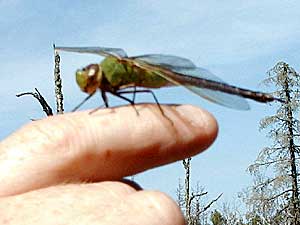|
Audio
Photos
Resources
Your Voice
|
North Woods dragonflies are migrating south
September 17, 2003
There are more than birds flying past Duluth's Hawk ridge this month. Avid hawk watchers have noticed another winged creature migrating south by the thousands -- dragonflies. Few people know that some dragonflies migrate. But Kurt Mead does. He's just written a field guide to dragonflies of the North Woods.
Duluth, Minn. — It's not really hard to find dragonflies. They're scattered around the globe. But to find lots of dragonflies, Kurt Mead wanders beyond the dirt road, through dark cedar stands and wild cranberry bushes, to a hidden peat bog in the heart of the Superior National Forest.
That's where Mead finds his favorite dragons, with names like Sanddragon or Dragonhunter. Mead bobs gently as he stands on a mass of floating green moss and whips his butterfly net.
 | |||
"Here's a pair of meadowhawks," he says, as he whips his butterfly net toward a pair of tiny winged creatures.
The Meadowhawks are maybe an inch long, with red needle-like bodies, bulging eyes, and paper-thin translucent wings.
Dragonflies have been around since prehistoric times. Mead says they used to be even more dragonlike.
"Three hundred million years ago. There's fossils. One fossil that was found in Germany had a 29-inch wingspan. (They) predate the dinosaurs by a long ways," says Mead. "There's fossil records of some species we still have today, so some of these species have been around for millions and millions of years."
Mead is clearly in awe of his tiny friends' hunting skills. They'll eat anything they can catch -- from mosquitoes to moths, smaller dragonflies, or even hornets.
 | |||
"The jaws are like these big plates, that along one margin are these big toothy appendages that stick out and grind and crunch," Mead says. "You can sneak up on them and you can actually hear them chew on these insects. They just crush them up."
Mead has his favorites.
"The Dragonhunter. It's large, black and yellow -- an awesome predator amongst awesome predators. It specializes in eating other dragonflies and large butterflies. It's just these huge legs; tiny little head and large body. It's just an awesome, awesome creature to see," says Mead.
And there's the Stygian Shadowdragon - a dark insect named after the mythical river Styx. The Shadowdragon hunts at dusk.
But there's one dragonfly that still eludes Mead.
"Ebony Boghaunter," he says. "It's sort of the holy grail of dragonflies in Minnesota right now."
 | |||
It should be here, but no one's ever seen one in Minnesota. Boghaunters live in small specialized populations. The Ebony Boghaunter should appear in May and might be found through June, but only in just the right small pond.
"I've spent some time looking, and didn't find it this spring, but I'm hopeful," says Mead. "Next spring we'll find it."
Minnesota is home to more than 90 species of dragonflies and damselflies -- a nearly identical insect to the untrained eye. But there could be many more. It's a study that's just catching on.
"The science of odonatology, or dragonfly and damselfly biology, is about the same place that ornithology, or the study of birds, was 100 years ago," says Mead. "So, we're actually 100 years behind."
One of the more remarkable are the Common Green Darners. These are relatively large insects -- about two inches long. And they migrate, all the way from northern states like Minnesota, as far as the Gulf Coast. Each generation flies one way, and the latest is ready for its September flight back south.
 | |||
Waves of Green Darners are now on their migration past Duluth's Hawk Ridge. Bird watchers and birds have taken notice.
"The kestrels and even some of the other smaller raptors will use them as a food source, to fuel their flight south," says Mead. "So, they're going the same direction."
It's a mid-September ritual. The Green Darners start moving with the first cold snaps in the North Woods.
"Keep your eyes upward, because you might be seeing masses, literally thousands at a time, flying silently overhead, treetop level and above," says Mead.
Mead's just written what he says is Minnesota's first field guide for the state's dragonflies. Dragonflies of the North Woods identifies more than 100 species that frequent the forests of the western Great Lakes.
Meanwhile, the Green Darner migration is underway, and could continue until frost.
|
News Headlines
|
Related Subjects
|

